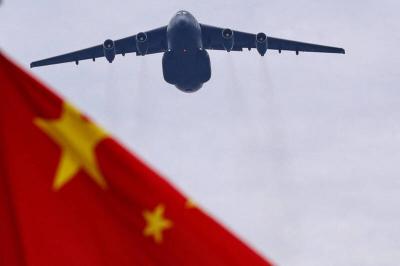Alleging the Environmental Protection Agency (EPA) deliberately kept important cases off the Environmental Impact Assessment Committee's (EIAC) agenda, a member of the committee protested outside the agency yesterday rather than attend the committee's last meeting.
Gloria Hsu (徐光蓉), Taiwan Environmental Protection Union chairwoman, said the EPA's "stalling tactics" means that environmental damaging construction projects likely to be rejected by committee could be approved by the next committee, whose members have yet to be convened.
Each EIAC has a two-year tenure, after which a new committee is selected by the head of the EPA.

PHOTO: CNA
"What is the point of attending the meeting?" Hsu said.
"Only five insignificant cases are discussed while many important cases that should have been brought before the committee languished," she said.
She was joined by former committee member Thomas Chan (
Both Hsu and Chan tied pieces of red fabric bearing the words "Environmental assessment is already dead," around their forehead.
Hsu accused the EPA of avoiding placing cases such as Formosa Plastic Groups' steelworks, the conjunctive utilization plan of Surface water and groundwater in the Chuoshui River alluvial fan and others before the current committee.
"They want to drag these cases out so that they will not go before this committee," Hsu said.
"I heard that our committee has been dubbed `the obstacle committee,'" he said.
"Are they delaying important cases from coming before the committee until it reconvenes with more business-friendly members?" Hsu said, "Why else are the keeping important cases from being heard?"
Also at the protest was the secretary-general of the TEPU, Ho Tsung-hsun (
"The EPA is derelict in its duty to protect the environment in Taiwan," Ho said, describing the agency as a "soft-legged shrimp" in the case of the sixth naphtha plant.
The agency previously meted out fines in March that was subsequently revoked by the Executive Yuan, Ho said.
At yesterday's press conference, EPA Deputy Director Chang Tzi-chin (張子敬) said the tenure of the current committee was about to end, meaning that there would not be enough time for the case of the sixth naphtha plant to come before it. However, Chang said the new limits will not necessarily be the 351,000 ton limit approved by the Industrial Development Bureau of the Ministry of Economic Affairs.
"It is up to the new committee, yet to be convened, to decide what the upper limit of water use could be for the sixth naphtha plant," Chang said.
Although fellow committee member Robin Winkler did not join Hsu's protest and attended the yesterday's meeting, he did offer a show of solidarity.
Coming down from the 13th floor where the meeting took place, Winkler ripped up a copy of the Basic Environmental Act (

Beijing could eventually see a full amphibious invasion of Taiwan as the only "prudent" way to bring about unification, the US Department of Defense said in a newly released annual report to Congress. The Pentagon's "Annual Report to Congress: Military and Security Developments Involving the People's Republic of China 2025," was in many ways similar to last year’s report but reorganized the analysis of the options China has to take over Taiwan. Generally, according to the report, Chinese leaders view the People's Liberation Army's (PLA) capabilities for a Taiwan campaign as improving, but they remain uncertain about its readiness to successfully seize

Taiwan is getting a day off on Christmas for the first time in 25 years. The change comes after opposition parties passed a law earlier this year to add or restore five public holidays, including Constitution Day, which falls on today, Dec. 25. The day marks the 1947 adoption of the constitution of the Republic of China, as the government in Taipei is formally known. Back then the Chinese Nationalist Party (KMT) governed China from Nanjing. When the KMT, now an opposition party in Taiwan, passed the legislation on holidays, it said that they would help “commemorate the history of national development.” That

Taiwan has overtaken South Korea this year in per capita income for the first time in 23 years, IMF data showed. Per capita income is a nation’s GDP divided by the total population, used to compare average wealth levels across countries. Taiwan also beat Japan this year on per capita income, after surpassing it for the first time last year, US magazine Newsweek reported yesterday. Across Asia, Taiwan ranked fourth for per capita income at US$37,827 this year due to sustained economic growth, the report said. In the top three spots were Singapore, Macau and Hong Kong, it said. South

Snow fell on Yushan (Jade Mountain, 玉山) yesterday morning as a continental cold air mass sent temperatures below freezing on Taiwan’s tallest peak, the Central Weather Administration (CWA) said. Snowflakes were seen on Yushan’s north peak from 6:28am to 6:38am, but they did not fully cover the ground and no accumulation was recorded, the CWA said. As of 7:42am, the lowest temperature recorded across Taiwan was minus-5.5°C at Yushan’s Fengkou observatory and minus-4.7°C at the Yushan observatory, CWA data showed. On Hehuanshan (合歡山) in Nantou County, a low of 1.3°C was recorded at 6:39pm, when ice pellets fell at Songsyue Lodge (松雪樓), a